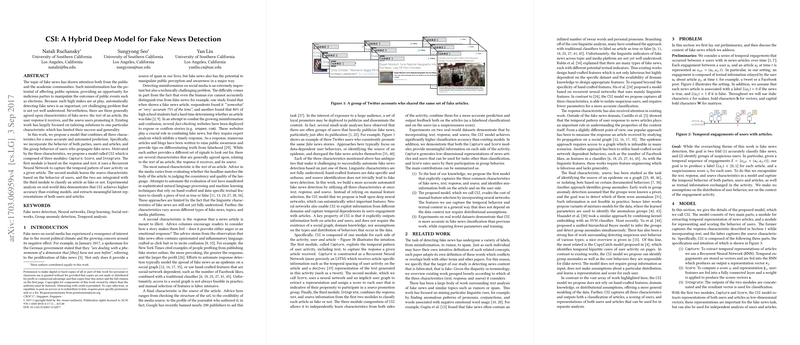Overview of "CSI: A Hybrid Deep Model for Fake News Detection"
The paper "CSI: A Hybrid Deep Model for Fake News Detection" addresses an important and timely issue in the field of information and misinformation on social media. Given the significant impact of fake news on public opinion and democratic processes, the authors propose a novel deep learning approach that integrates three critical characteristics for fake news detection: the text of an article, the user response it elicits, and the behaviors of the users who propagate it.
Model Structure and Modules
The core of the proposed model, named CSI, is composed of three interconnected modules:
- Text and Response Module (TRM):
- This module focuses on capturing the temporal engagement patterns of users with an article. It utilizes a Recurrent Neural Network (RNN), specifically a Long Short-Term Memory (LSTM) network, to analyze the sequence of engagements that an article receives over time.
- Important feature vectors included are the frequency and distribution of user engagements, user features derived from Singular Value Decomposition (SVD), and textual content represented via doc2vec.
- Source Module (SM):
- This module evaluates the behavior of users who engage with articles, scoring them based on their propensity for suspicious activity. This is done by constructing an implicit user graph and applying SVD to generate user features.
- A network then assigns a suspiciousness score to each user, indicative of their likelihood to promote fake news. This score is then integrated with article features.
- Classification Module:
- The classification module combines outputs from the TRM and SM to produce a final prediction on whether an article is fake or not. It uses a final fully connected layer that integrates the temporal and textual features of the engagement with the source behavior scores.
Experimental Evaluation and Results
The authors validate the CSI model using two real-world datasets: Twitter and Weibo. Compared to five state-of-the-art baseline models—such as SVM-TS, DT-Rank, DTC, LSTM-1, and GRU-2—CSI achieves superior performance in terms of accuracy and F-score. Notably:
- CSI outperformed the best baseline model by a margin exceeding 4% in accuracy.
- The integration of user features contributed significantly to the detection capabilities, reinforcing the hybrid approach's strength.
- CSI requires fewer parameters and training samples than other RNN-based models, demonstrating its efficiency and robustness in detecting fake news.
Analysis of User and Article Representations
The paper also explores the interpretability of the user scores and article representations generated by the CSI model:
- User Scores: There is a strong positive correlation between the scores assigned to users and their engagement with fake news, validating the source module's effectiveness in capturing suspicious behaviors. Users marked as suspicious based on CSI's scoring are often those who engage rapidly and frequently with fake news articles.
- Article Representations: The CSI model produces meaningful low-dimensional vectors representing the temporal and textual response an article receives. These vectors can be used for additional analytical tasks, such as clustering different types of articles based on their engagement patterns.
Practical and Theoretical Implications
The proposed CSI model contributes significantly to the theoretical framework for fake news detection by:
- Highlighting the importance of integrating multiple characteristics—text, response, and source—in a single model to enhance detection accuracy.
- Demonstrating that deep learning models, when equipped with well-designed feature inputs and modular architecture, can effectively tackle complex phenomena such as fake news propagation.
- Providing a flexible and expandable framework that allows for the incorporation of more advanced features and techniques, including profile information and advanced natural language processing tools.
Future Directions
The research opens several pathways for future exploration:
- Incorporating Reinforcement Learning: Integrating user feedback into the fake news detection process may lead to more adaptive and accurate models that evolve over time.
- Crowdsourcing and Human-AI Collaboration: Harnessing human expertise in conjunction with AI could greatly enhance the timeliness and reliability of fake news detection. Models that learn from human input could be particularly beneficial in rapidly evolving information environments.
In conclusion, the CSI model represents a substantial advance in the automated detection of fake news, providing a robust, scalable, and insightful tool for combating misinformation on social media. Its ability to encapsulate complex user behaviors and temporal dynamics into a deep learning framework sets a new benchmark for future research in this domain.
